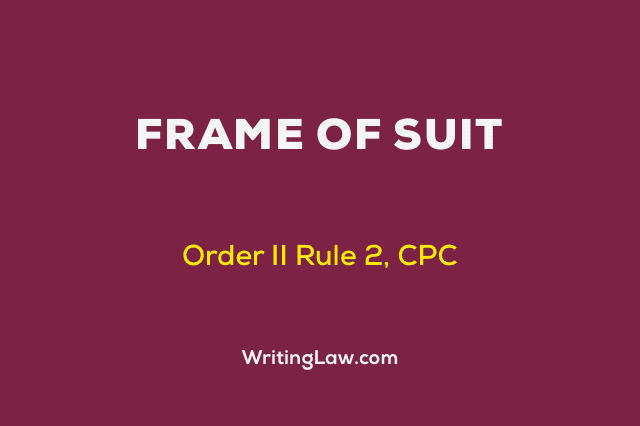
Order II of the Civil Procedure Code deals with the framing of suit. It lays down the rules as to how a suit should be framed.
While drafting a plaint, the plaintiff must draft his plaint in such a way that includes all the important assertions and the claims that the plaintiff wishes to put before the court. Nothing important should be left for inclusion in the plaint.
It is the plaint of the plaintiff which speaks in court before a judge. The plaint should be such which can take a case towards the conclusion for a final decision. All the subject matter in dispute must be decided at once.
Suit to Include Whole Claim, Order II Rule 2
The plaintiff in his plaint must include the whole of the claim, which he wishes to seek from the court. For the purpose of bringing the suit within the jurisdiction of any court, the plaintiff may relinquish or abandon any part of his claim.
Example 1
A files a suit against B for recovery of money. The amount to be recovered is three crores. For the purpose of falling in the pecuniary jurisdiction of the district court, A files a suit for recovery of money of two crores only.
Here A has relinquished his part of the claim (of rupees one crore) for the purpose of bringing suit within the pecuniary jurisdiction of the district court. As the pecuniary limits of Delhi district court is up to two crores. If he would have to make the whole of his claim, then the jurisdiction would have fallen under Delhi High Court.
Relinquished Part of Claim
Once a relinquishment always a relinquishment. If the plaintiff omits to assert his claim or intentionally relinquishes any part of the claim, then he loses the right to sue for it afterwards. Later on, the plaintiff can’t assert for the claim he has relinquished. The court will not entertain the claim.
Example 2
With reference to example 1 mentioned above: The claim which the plaintiff relinquished in order to bring the suit within the pecuniary jurisdiction of Delhi district court, can’t be raised subsequently in a different suit. If the plaintiff has omitted or intentionally relinquished his portion of the claim, then he can’t sue for it afterwards.
Omission to Sue For One of Several Reliefs
If the plaintiff is entitled to more than one relief for the same cause of action, he must sue for all such reliefs. If he omits to sue for any one of several reliefs, then he can’t bring another suit for claiming such relief.
Exception to the Above Rule
If the plaintiff takes the leave of the court for relinquishing any of his relief, then he may sue for such relief afterwards. With the leave of the court, Order II Rule 2 does not bar such relief. But if the leave not taken, then there will be a bar under Order II Rule 2 of CPC.
Example 3
A is the landlord and B a tenant. B has not paid rent for the last three years and is in wrongful possession of the property. A files a suit against B for the possession of the property. A in a subsequent suit claims for the arrears of rent against B. The subsequent suit is barred under Order II Rule 2 of the Civil Procedure Code.
Case Laws on Order II Rule 2, CPC
Mohd. Khaleel Khan vs. Mohd. Mia Ali, 1949: Privy Council held that if the relief claimed in a new suit is based upon the same cause of action as of former suit, then it shall attract the bar under Order II Rule 2. If the relief claimed is distinct from the former cause of action, then it will not be barred under Order II Rule 2 of the Civil Procedure Code.
Gurubux Singh vs. Bhoora Lal, 1964: The supreme court laid down some conditions for applying Order II Rule 2. If the conditions satisfy, then the bar of Order II Rule 2 comes under operation. The conditions are as follows:-
1. Cause of action in the subsequent suit or new suit must be the same as that of the previous suit.
2. Where the plaintiff is entitled to more than one relief and relinquishes any one of such reliefs without the leave of the court and files a new suit for the relief of which he was entitled to in previous suit.
3. The previous suit must have been decided on merits.
Object of Order II Rule 2
The object behind Order II Rule 2 is to prevent the multiplicity of cases. Already the court is burdened with lakhs of cases. The purpose behind this rule is that defendant should not be put in trouble twice for the same cause of action. The matter should be decided at once on merits. Multiple claims raise confusion and destroy the precious time of the court. Hence, the significance of Order II Rule 2 is appreciated in the framing of a suit.
- 18 Most Important Amendments to the Indian Constitution - 12th August 2023
- 8 Kinds and Theories of Punishment - 22nd July 2023
- What Is the Meaning of Res Judicata in Civil Procedure Code? - 22nd January 2023








Excellent notes.. keep it up
Good
Your notes are very much helpful. Thanks alot!!!
Thank You.
Respected sir,
The notes you give is very helping ,it has helped me a lot as i am preparing for my judicial exams.
Glad that these notes are useful to you.
You are doing good. Your notes is helping me a lot. Thanks a million
Thank you. You words are valuable.